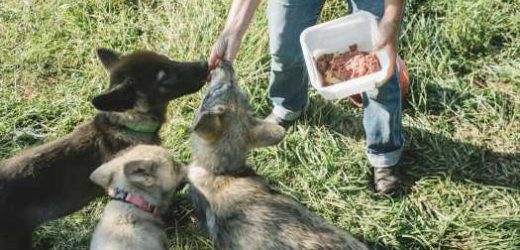It’s the middle of the last ice age and you are in the cave on a cold winter’s night chewing the fat, and I don’t mean gossiping. You are chewing real, gristly fat from some animal you just killed and cooked because if you eat only lean meat you’ll starve to death or get protein poisoning. By evolutionary necessity, you find fat irresistible. Many thousands of years later this will cause your descendants to eat Doritos and Slim Jims, but that’s not your problem.
Sill, you have leftover lean meat because that’s not the part of the musk ox that people like. What to do with it? Toss it to the wolf pup! You don’t know why you took the beast in, but it’s cute, and it seems to thrive on the parts of the kill you don’t favor. If this happens often enough, and you and your children and their children end up keeping some of these wolves and their progeny, what do you get? Dogs!
Maria Lahtinen, an archaeologist at the Finnish Food Authority, and a group of colleagues published this idea in a bit more scientific detail on Thursday in the journal Scientific Advances. Dr. Lahtinen, whose main research is not on domestication but the diet of Arctic and sub-Arctic people, had a notion that the different dietary needs of humans and wolves could be key to the origin of dogs. It is, she said, “a completely new hypothesis why initial dog domestication took place.” Two species, both carnivores to a greater or lesser extent, with different nutritional needs, could have a commensal relationship. The wolves would benefit and the humans, at least at first, would neither lose nor benefit.
The process of dog domestication, in which a now extinct group of wolves was transformed into dogs, has always been a puzzle. Scientists agree it happened 15,000 years ago or longer, likely in Eurasia. But some scientists say ancient wolves gradually came closer to humans as they fed on their garbage. Others argue that the hunter-gatherers of the time wouldn’t have had enough waste to make that work. They argue that hunter-gatherers nabbed wolf puppies from their dens and kept them as pets. But nabbing a wolf pup and socializing it to live with people isn’t that easy, and having your children eaten would be a significant downside. Besides, weren’t humans and wolves competing for the same prey?
Dr. Lahtinen and her colleagues take competition out of the equation. In winter, ice age humans would have had to forego plants, depending on hunting. But people can’t survive on protein alone. Eventually they starve or get protein poisoning. They need fat, so they would have eaten primarily the fatty parts of prey, with some lean meat left over. Wolves, with different digestive systems, can live for quite a while on pure protein.
The researchers say in their paper that among human Arctic hunters, animal protein could have provided up to 45 percent of the calories needed in the winter. They also calculated the amount of protein in the prey available to wolves in the ice age, showing that they have protein “over the limits that humans can consume.” People and wolves hunt similar species, so if humans were consuming the same animals they would have excess protein from their kills.
Humans, including modern hunter-gatherers, have an odd habit of feeding other animals and keeping them, at least for a while. So the authors lean toward the idea of various human bands occasionally snatching a wolf puppy. Eventually, the two species grew closer together and the new dog-wolves became useful. Many thousands of years later, we have pandemic puppies.
The hypothesis is just that, an idea about what might have happened, not a demonstration of what did happen. But Naomi Sykes, a zoo-archaeologist at the University of Exeter in Britain, who reviewed the paper for publication, said she thought the researchers made two important points. “The first is their suggestion that there would have been minimal dietary competition between humans and wolves.” The second, she said, was that their hypothesis “flips the idea of domestication” to people feeding animals rather than raising them to eat.
She said archaeological finds indicate that the domestication of chickens, rabbits, horses and other animals may have begun with the animals being deliberately fed. In some of the earliest discoveries, she said, the ancient bones show that the animals were “being maintained, looked after and even worshiped rather than eaten.”
For wolves, she said, she didn’t favor the puppy-snatching part of the hypothesis. The presence of leftover protein, either at the site of the kills or in camps, would have been enough for the humans and wolves to draw closer.
Leftovers are delicious however you come by them.
Source: Read Full Article


